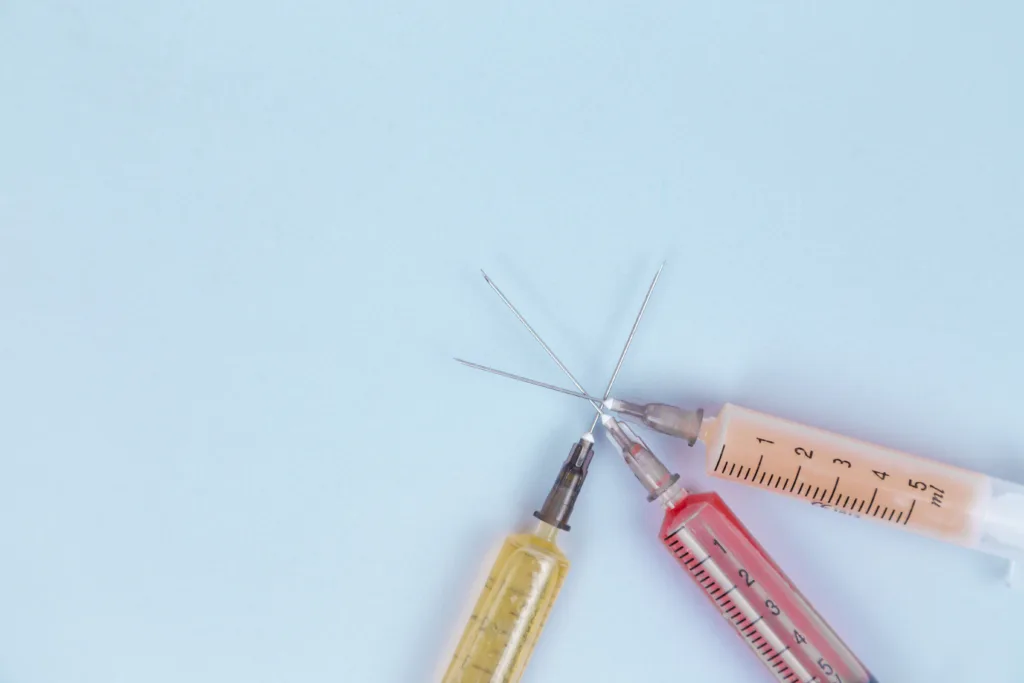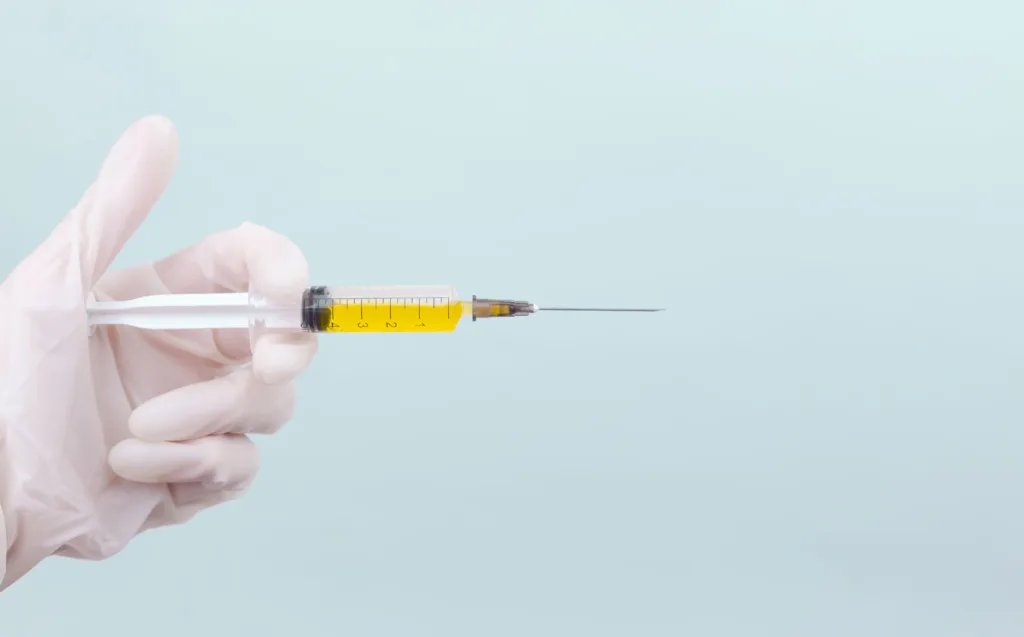A syringe is a medical tool that is used to inject medication or extract fluids from the body. It consists of several parts that work together to make the process of administering medication or extracting fluid as safe and efficient as possible.
The first part of a syringe is the needle. This is a sharp, hollow tube that pierces the skin and enables medication to be injected into the body. There are different types of needles, including those that are short and thin, and those that are long and thick. The size and type of needle used will depend on the type of medication being administered and the location of the injection site.
The second part of a syringe is the barrel. This is where the medication is held in the syringe before injection. The barrel is usually transparent so that the medical professional administering the medication can see how much medication is being injected into the body. The barrel is also marked with measurements so that the medical professional can accurately measure the amount of medication being administered.
The tird part of a syringe is the plunger and piston. The plunger fits into the barrel and is used to push the medication out of the syringe and into the body. The piston is a component of the plunger that seals off the medication in the barrel and prevents it from leaking out.
There are also different types of syringe tips. The Luer-Lok tip engages the hub of the needle with a threaded locking mechanism, which keeps the needle from coming off. The Luer-Slip tip secures a needle using friction after the needle hub slides or “slips” onto the tip. Catheter syringes have the largest style tip design, while oral syringes appear similar to a Luer-Slip.
A syringe is an essential medical tool that consists of several important components. The needle pierces the skin and enables medication to be injected into the body, while the barrel holds the medication before injection. The plunger and piston work together to push the medication out of the syringe and into the body. It is important for medical professionals to choose the appropriate syringe and needle size and type for each patient and medication to ensure safe and effective administration.
What Are The Four Parts Of A Syringe?
A syringe is a medical instrument that is used to inject medication or withdraw fluids from the body. It is made up of four essential parts: the needle, the barrel, the plunger, and the piston.
The needle is a sharp, hollow tube that is responsible for piercing the skin and delivering the medication into the body. It is designed to be thin and precise, and it comes in a variety of lengths and gauges depending on the intended use.
The barrel is a transparent chamber that holds the medication befoe injection. It is usually graduated with markings that allow for accurate measurement of the medication being administered. The barrel is typically made of plastic or glass and is designed to be sturdy enough to withstand pressure without cracking.
The plunger is a small rod that fits snugly inside the barrel. It is attached to the piston and is used to draw medication into the barrel or push it out of the needle. The plunger is typically made of plastic or rubber and is designed to be easy to grip and manipulate.
The piston is a small disk that fits inside the barrel and is attached to the plunger. Its purpose is to create a vacuum that allows medication to be drawn into the barrel or to push the medication out of the needle. The piston is typically made of rubber or plastic and is designed to be airtight to prevent leakage.
By understanding the four essential parts of a syringe, medical professionals can ensure that they are using this important instrument safely and effectively.

What Are The Parts Of The Syringe And Their Functions?
A syringe is a medical tool that is used to inject or withdraw fluids from the body. The parts of a syringe and their functions are as follows:
1. Barrel: The barrel is the main body of the syringe. It is typically made of plastic or glass and is marked with measurements to indicate the amount of fluid being drawn or injected.
2. Plunger: The plunger is a long, thin rod that fits inside the barrel. It is used to draw fluid into the syringe or push fluid out of it. The plunger is typically made of plastic or rubber.
3. Needle: The needle is a sharp, thin metal rod that is attached to the end of the syringe. It is used to pierce the skin and inject or withdraw fluids from the body.
4. Hub: The hub is the part of the syringe that attaches the needle to the barrel. There are two types of hubs: Luer lock and Luer slip. Luer lock hubs engage the hub of the needle with a threaded locking mechanism, while Luer slip hubs secure a needle using friction after the needle hub slides or “slips” onto the tip.
5. Catheter: Catheter syringes are the largest style tip design. They are typically used to inject or withdraw fluids from larger parts of the body, such as the bladder.
6. Oral Tip: This type of tip appears similar to a Luer slip. It is typically used to administer medication orally, such as to a baby or young child.
The syringe has several parts, each with a specific function. The barrel and plunger work together to draw or push fluid into or out of the syringe. The needle, hub, catheter, and oral tip are all used to administer medication or withdraw fluids from different parts of the body.
What Are The 5 Parts Of A Needle?
A needle is a small, slender instrument that is used for a variety of medical procedures. It is composed of several distinct parts that work together to deliver medication or draw blood. The five parts of a needle include the hub, shaft or cannula, bevel, plunger, and barrel.
1. Hub – The hub is the part of the needle that attaches to the syringe. It has a small opening that allows medication to pass through.
2. Shaft or Cannula – The shaft or cannula is the long, slender stem of the needle that is beveled at one end to form a point. It is typically made of stainless steel and is designed to be strong and durable.
3. Bevel – The bevel is the slanted part of the needle that is created by grinding the tip of the shaft at an angle. It is this bevel that allows the needle to pierce the skin and enter the blood vessel or tissue.
4. Plunger – The plunger is a small, cylindrical piece that fits into the barrel of the syringe. It is used to push medication out of the syringe and into the patient’s body or to draw blood into the syringe for testing.
5. Barrel – The barrel is the hollow, cylindrical part of the syringe that holds the medication or blood. It is typically made of plastic or glass and is marked with measurements to ensure accurate dosing.
The five parts of a needle are the hub, shaft or cannula, bevel, plunger, and barrel. Each of tese parts plays an important role in the delivery of medication or the collection of blood for testing.
What Are The 3 Types Of Syringes?
There are three main types of syringes in use today. These include Luer-Lok, Luer-Slip, and Luer-Taper syringes. Here is a brif explanation of each type:
1. Luer-Lok syringes: These syringes come with a locking mechanism that prevents the needle from coming off accidentally. The needle is twisted and locked securely into place, ensuring that it stays in place during the injection process.
2. Luer-Slip syringes: These syringes do not have a locking mechanism like the Luer-Lok syringes. The needle simply slips onto the end of the syringe and is held in place by friction. This type of syringe is generally less expensive than the Luer-Lok variety.
3. Luer-Taper syringes: These syringes have a tapered tip that allows for a more precise injection. The needle fits onto the tapered tip securely, ensuring that the medication is delivered exactly where it needs to go. These syringes are often used for more complicated injections that require a high degree of accuracy.
All three types of syringes have their own unique features and benefits, and the choice of which one to use will depend on the specific needs of the patient and the healthcare provider.

Conclusion
A syringe is a medical device that is used for injecting medication or withdrawing bodily fluids. It consists of seveal parts, including the needle, barrel, plunger, and tip. The needle is a sharp hollow tube that pierces the skin and delivers medication into the body. The barrel is where the medication is held before injection and is usually transparent to allow for easy measurement and visualization. The plunger and piston work together to push medication out of the syringe or draw it in. the tip of the syringe can vary in design depending on the intended use, with Luer-Lok, Luer-Slip, and Luer-Taper being the most common types. Understanding the various parts of a syringe is important for medical professionals to ensure safe and accurate administration of medication.
